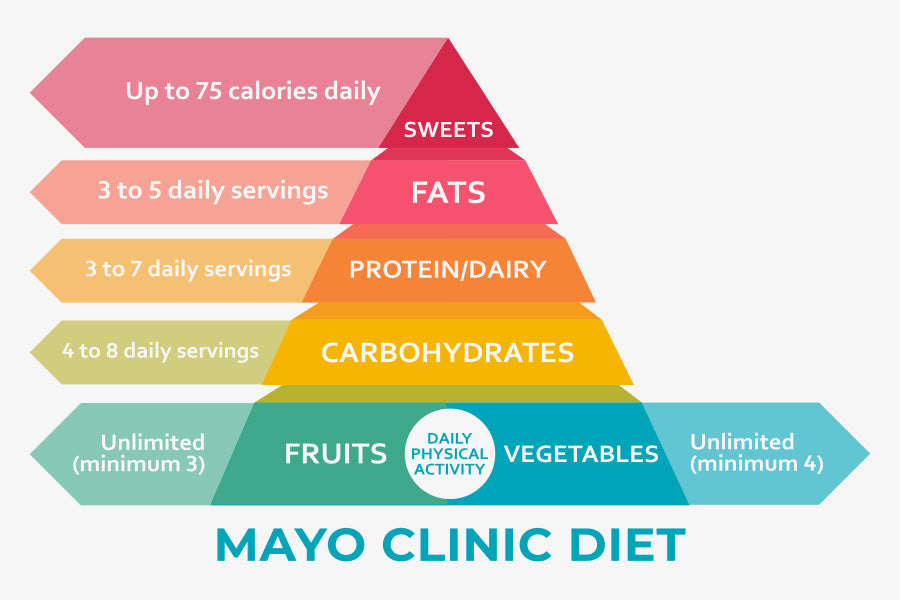The Mayo Clinic Diet is a lifestyle plan to help people make positive choices for long-term weight loss and health. Experts developed it at the world-renowned Mayo Clinic, a not-for-profit medical research organization in Rochester, Minnesota.
The program is based on principles of healthy eating, regular physical activity, and healthy lifestyle habits, such as getting enough sleep and managing stress. Through careful planning and an understanding of nutrition science, the Mayo Clinic Diet can help people reach their weight loss goals while promoting overall health.
With its focus on lasting positive changes to eating behaviors, you can try the Mayo Clinic diet for weight loss. These diets are designed to help people achieve long-term success with maintaining a healthy weight. This article discusses the Mayo Clinic diet, its benefits, risks, how it works, and a sample menu.
Related Article: The IIFYM & Flexible Dieting Plan
What is the Mayo Clinic Diet?
The Mayo Clinic Diet is based on a practical, evidence-based approach to healthy eating that encourages positive lifestyle changes. The program aims to promote long-term weight loss without crash dieting or quick-fix solutions.
The Mayo Clinic Diet outlines five main food groups—fruits, vegetables, whole grains, lean protein sources, and healthy fats—as dietary guidelines.
The program encourages making thoughtful choices about food, such as opting for whole grains over refined carbohydrates and choosing lean proteins instead of processed meats.
The program’s focus on mindful eating encourages people to think critically about the foods they’re consuming and be conscious of their portion sizes. It also provides practical information on planning meals, choosing healthier options, and managing food cravings.
Its emphasis is on overall health, and it encourages people to make lasting changes that will benefit their well-being in the long run. The diet is not a quick-fix solution; it is designed to help people establish healthy habits for lasting weight management and overall health.
The Mayo Clinic Diet has two components: the Lose It Phase and the Live It Phase. The Lose It Phase is designed to reduce your calorie intake to lose weight quickly and safely. The Live It Phase focuses on making healthy lifestyle changes that will last longer.
The Mayo Clinic Diet is not a fad diet, nor is it a quick-fix solution. Instead, it provides long-term results by encouraging individuals to change their lifestyles. By creating an individualized plan tailored to your particular needs and goals, the Mayo Clinic Diet can help you create sustainable habits that will keep you healthy for years to come.
How Does the Mayo Clinic Diet Work?
The Mayo Clinic Diet is a long-term approach to weight management that helps people make positive changes to their diet and lifestyle. Through its Lose It and Live It Phases, the program teaches individuals how to positively modify their eating habits and lifestyle to help them reach their goals.
The Lose It Phase is the initial stage of the program and involves reducing calorie intake while eating nutritious foods and increasing physical activity. During this phase, people learn to adjust their portions, reduce cravings for unhealthy foods, and make healthier food choices.
Live It Phase is designed to help people lose weight by making healthy lifestyle changes. Individuals learn to balance nutrition and physical activity to maintain a healthy weight. People also receive guidance on stress management, sleep habits, and more.
The first phase of the diet, which lasts two weeks, intends that you lose 6-10 pounds. After those fourteen days are up, you transition into the "Live it!" stage, where you follow similar rules but with more laxity--occasional breaks are allowed. Even though advocates of this diet say calorie counting isn't necessary, the Mayo Clinic Diet still recommends limiting your intake.
Depending on your weight, women should consume 1,200-1,600 calories daily while men require 1,400-1,800. The diet then provides serving recommendations for vegetables, fruits, carbs, etc., based on your calorie goals.
Related Article: How to Start Eating Healthy: A Guide to the 1500-Calorie Meal Plan
Can I Lose Weight on the Mayo Clinic Diet?
Yes, you can lose weight on the Mayo Clinic Diet. The program is designed to help individuals make positive changes to their diet and lifestyle to reach their weight loss goals.
While research is ongoing, many studies have found that there are certain things you can do to help manage your weight. For instance, one study with over 3,000 people showed that those who increased their intake of fiber from fruits and vegetables while reducing their saturated fat intake saw lower weights after one year than those who didn't make these changes.
Additionally, other studies show that exercising while on a lower-calorie diet is more effective at promoting weight loss than dieting alone. If you're looking to manage your weight, increasing your fiber and cutting down on saturated fats is an excellent place to start, and don't forget the importance of exercise!
According to research, low-calorie diets are most effective at promoting weight and fat loss when combined with exercise, especially resistance training.
Furthermore, dieting and exercising simultaneously help retain muscle mass, which could further promote weight loss by increasing metabolism.
Health Benefits of the Mayo Clinic Diet
In addition to helping individuals reach their weight loss goals, the Mayo Clinic Diet also offers several health benefits. By following this program, people can make lasting changes to their diet and lifestyle to improve their overall well-being.
Protects You Against Chronic Diseases
According to recent studies, consuming more fruits and veggies can decrease the likelihood of developing cancer, heart disease, and premature death. In addition, the Mayo Clinic Diet suggests that adults get a minimum of 30 minutes of exercise each day to help reduce the chances of chronic diseases such as diabetes and heart disease.
Another benefit of regular exercise is improving insulin sensitivity and lowering blood sugar levels.
Reduces Your Risk of Heart Diseases
Did you know you're decreasing your risk of heart disease? It's true! Exercising has improved your heart health. Lowering inflammation reduces risk factors for heart disease.
Changes Your Approach Towards Weight Loss
The Mayo Clinic Diet takes a different approach: it focuses on behavior-based changes, like adding exercise to your routine or eating more fruits and vegetables. This weight loss intervention may result in more significant weight loss than other diets.
Helps Minimize Diabetes Risk
According to a large study that looked at 124 other studies, people who participated in weight-loss programs based on changing their behavior lost more weight than those who didn't participate. They also were less likely to regain weight and had a lower risk of developing diabetes.
Health Risks of the Mayo Clinic Diet
While the Mayo Clinic Diet is a safe and effective program, some health risks are associated. It is essential to consult with a healthcare provider before starting any new diet or exercise regimen.
Restrictive Calorie Count
The Lose It phase may be too restrictive for some people, as it severely limits their calorie intake, which can lead to nutritional deficiencies.
Challenging to Stick to the Diet
The Live It phase may be challenging for some people, as it requires a significant change in lifestyle and habits.
May Cause Higher Blood Sugar Levels
Furthermore, the natural sugar in fruit will affect your carbohydrate intake if you consume considerable fruit. This could cause a temporary spike in blood sugar or certain blood fats; this effect is lessened while losing weight.
Not Suitable for Chronic Health Conditions Patients
If you have diabetes or other health conditions, always consult your doctor before changing your diet. That being said, the Mayo Clinic Diet can be adjusted to fit different situations.
For example, people with diabetes should consume more vegetables than fruit if possible. An excellent way to eat healthier is by munching on veggies rather than blindly snacking fruit.
Sample Mayo Diet Plan
This is a mayo clinic 3-day diet menu for a 1,200-calorie diet. If you want to plan for more calories, increase the servings of carbs, protein, dairy, and fats. You can also have the mayo clinic diet pdf.
Day One
- Breakfast: 3/4 cup (68 grams) of oatmeal, 1 apple, black coffee or tea
- Lunch: 2 cups (472 grams) mixed greens with 3 ounces (85 grams) tuna fish, 1/2 cup (43 grams) low-fat shredded cheese, 1 whole wheat toast slice with 1 1/2 teaspoons(7 grams ) margarine, and blueberries ½ cup (75 grams)
- Dinner: 3 ounces of tilapia cooked in 1 1/2 teaspoons of olive oil, roasted potatoes, and cauliflower.
- Snacks: Orange and baby carrots with whole grain crackers
Day Two
- Breakfast: 1 slice of whole wheat toast with 1 1/2 teaspoons (7 grams) of margarine, 3 egg whites, and 1 pear
- Lunch: 3 ounces (85 grams) of grilled chicken, 1 cup (180 grams) of steamed asparagus, 6 ounces (170 grams) low-fat yogurt & ½ cup of raspberries
- Dinner: 3 shrimp cooked in olive oil over ½cup brown rice and broccoli
- Snacks: Banana & cucumber slices w/ 2 rice cakes
Day Three
- Breakfast: Oat bran flakes (30 grams), skim milk (240 mL), half a banana, black coffee or tea
- Lunch: Whole wheat toast (1 slice) with sliced turkey (3 ounces/85 grams), margarine (1.5 teaspoons/7 grams), grapes (1.5 cups)
- Dinner: Cooked whole wheat pasta(1 cup/100 grams, low fat tomato sauce (.5 cup /120 grams) grilled chicken breast (3 ounces/85 grams) green beans cooked in olive oil (1.2teaspoons)
- Snacks: pear and cherry tomatoes
Conclusion
In conclusion, the Mayo Clinic Diet is a safe and effective program that can help individuals reach their weight loss goals while making positive changes to their diet and lifestyle. However, it is essential to consult a healthcare provider before beginning this program and know its potential health risks.
With the help of a healthcare provider and the guidance of this program, individuals can learn how to make lasting changes to their health and well-being.
Reading List
Article Sources
- Clark, James E. “Diet, Exercise or Diet with Exercise: Comparing the Effectiveness of Treatment Options for Weight-Loss and Changes in Fitness for Adults (18–65 Years Old) Who Are Overfat, or Obese; Systematic Review and Meta-Analysis.” Journal of Diabetes and Metabolic Disorders, vol. 14, Apr. 2015, p. 31. PubMed Central, https://doi.org/10.1186/s40200-015-0154-1.
- LeBlanc, Erin S., et al. “Behavioral and Pharmacotherapy Weight Loss Interventions to Prevent Obesity-Related Morbidity and Mortality in Adults: Updated Evidence Report and Systematic Review for the US Preventive Services Task Force.” JAMA, vol. 320, no. 11, Sept. 2018, pp. 1172–91. Silverchair, https://doi.org/10.1001/jama.2018.7777.
- Röhling, Martin, et al. “Influence of Acute and Chronic Exercise on Glucose Uptake.” Journal of Diabetes Research, vol. 2016, Mar. 2016, p. e2868652. www.hindawi.com, https://doi.org/10.1155/2016/2868652.








